Consumer behavior (or customer behavior) is a broad topic. No consumer is the same so figuring them out is quite a complicated task.
The good news is that there are a lot of smart people who study consumer behavior. They came up with a lot of solid theory that you can apply to your own customers.
The bad news is that you still have a job to do when it comes to putting the theory into practice.
But you’re not on your own with this. With a mix of proper tools, you can uncover some bits of your customers’ behavior and motivations.
And we’re going to start with something simple – live chat and chatbots.
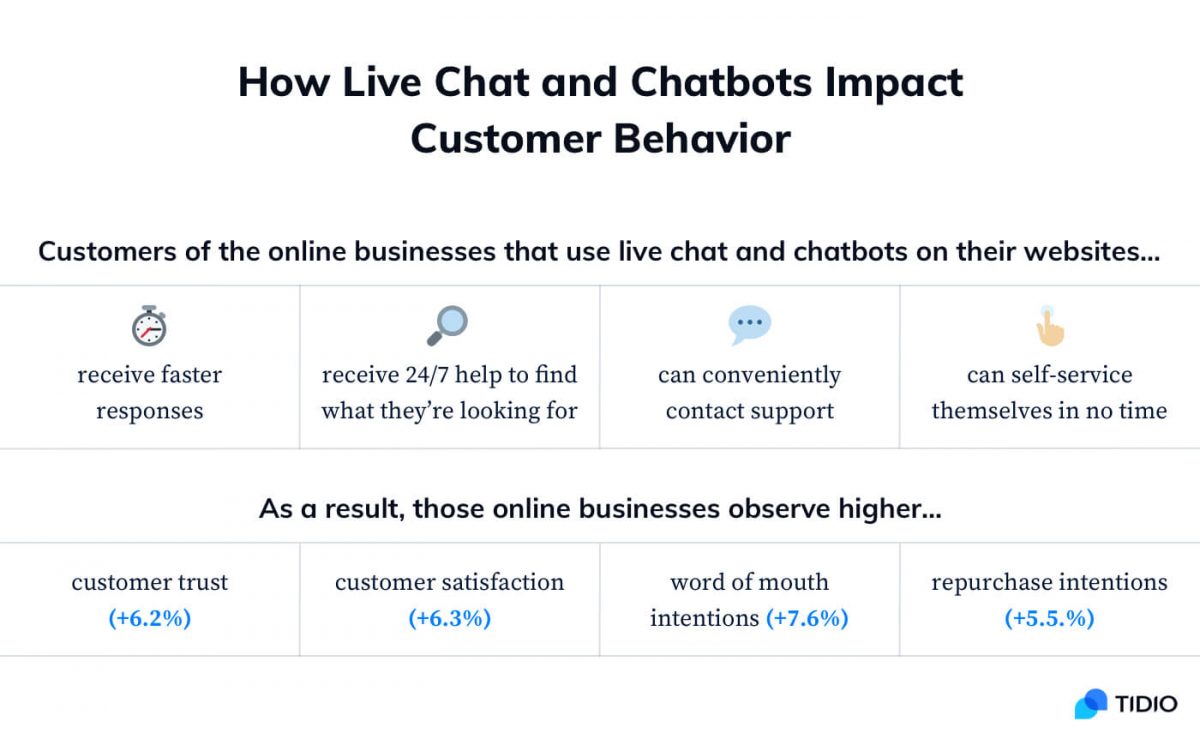
From this article, you will find out:
- What is buyer behavior?
- How knowing your customers can get you more sales?
- How can you use Tidio to collect data about your visitors and customers?
Assist your customers in real time with smart live chat tools
Consumer Behavior—Definition and Examples
Let’s start with the basics.
What does consumer behavior mean?
Consumer behavior studies consumers and the processes they go through when they choose and use the products (or services). It focuses on consumers’ emotional, mental, and behavioral responses. Therefore, consumer behavior borrows ideas from several sciences including psychology, biology, chemistry, and economics.
Consumer behavior is also about how consumers do their shopping (as opposed to who is shopping). It takes into account several factors, such as:
- customers’ shopping frequency
- customers’ products preference
- customers’ perception of marketing, sales, and customer service
Before the consumer decides to buy something, they follow these five steps:
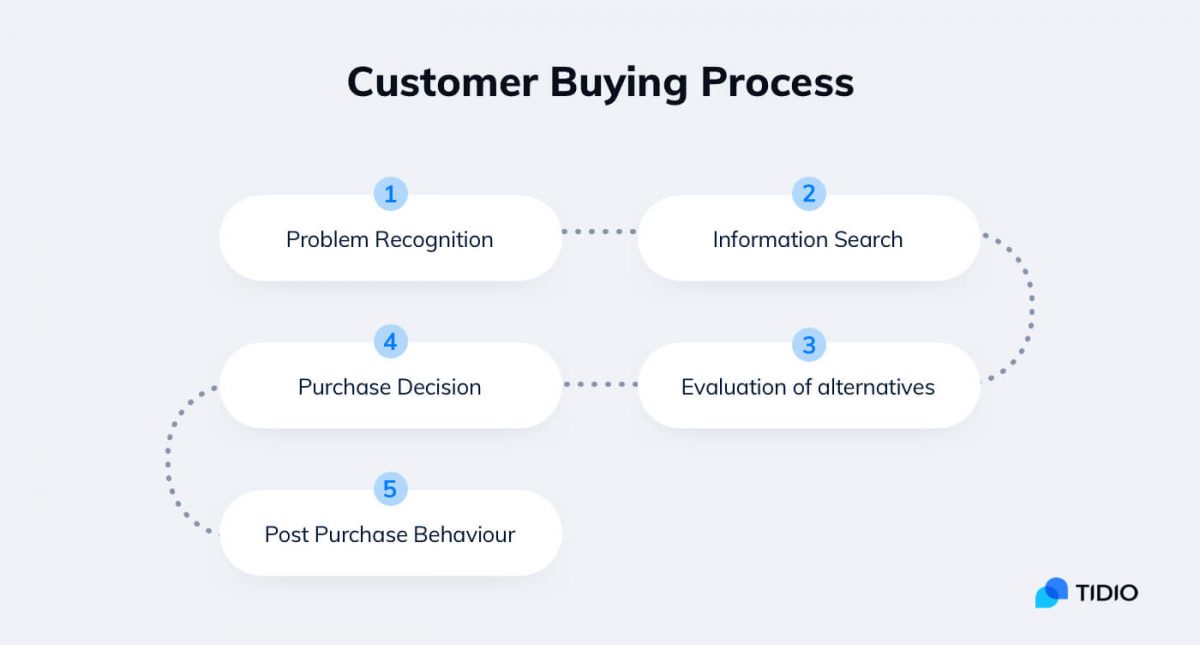
Customer behavior analyses customers on each of those steps. It takes into account three factors influencing consumer behavior:
- Psychological factors: beliefs, motivation, perception, attitude, and learning.
- Social factors: family, friends, celebrity, education, social class, income, etc.
- Personal factors: interests, opinions, age, gender, culture, background, etc.
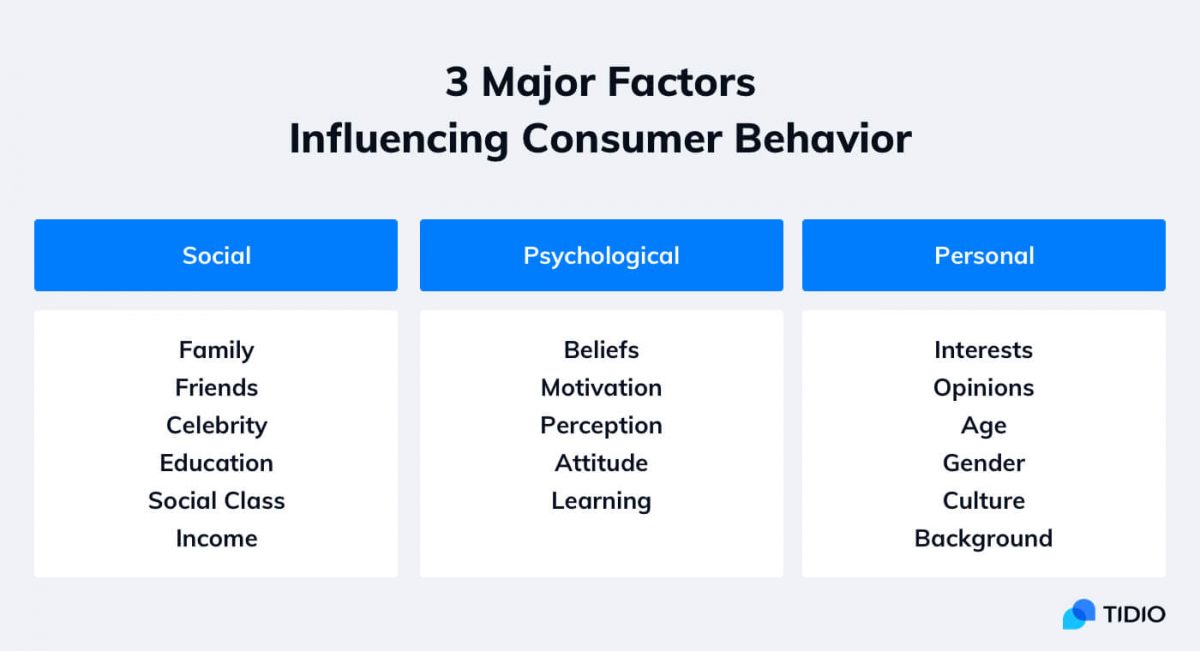
Now, think for a moment about your customers and the buying process in general. What questions would you ask to understand their choices and why? Have a look at several customer behavior example questions below:
Consumer Behavior — Examples of Questions to Ask
How did they find out about my brand, product, or service?
Focus on the searching process. Knowing how your customers find you will allow you to find out which acquisition channels work better.
How do my customers feel (or think) about my brand, product, or service?
By knowing what your customers love and hate about you can help you capitalize on your strengths and focus on weaknesses.
Why did they choose my brand, product, or service over the competition?
Was it the price? The description? The image or copy you have used in your ad? Try to identify the factors that influenced your customers’ decisions. Depending on your audience, some things will work better than others.
How do they use the goods or services they bought from me?
There are many types of goods and services. And customers buy them due to many reasons, as well. For instance, to meet basic needs, to solve a problem, to boost their egos, or to make other people happy.
The Importance of Consumer Behavior
Customer behavior is important for both sides: the buyer and the seller.
The buyer expects the seller to know what their problems and needs are. That’s why the personalization of products and services plays a major role in customer experience (CX).
The seller’s role is to solve the buyer’s problems with their products or services. If they don’t, they risk product failure. After all, services and products are for customers, not for their own sake.
Moreover, fashion, technology, trends, lifestyle, and disposable income change over time. So by knowing what the customers want, sellers not only secure the present but also get ready for the future.
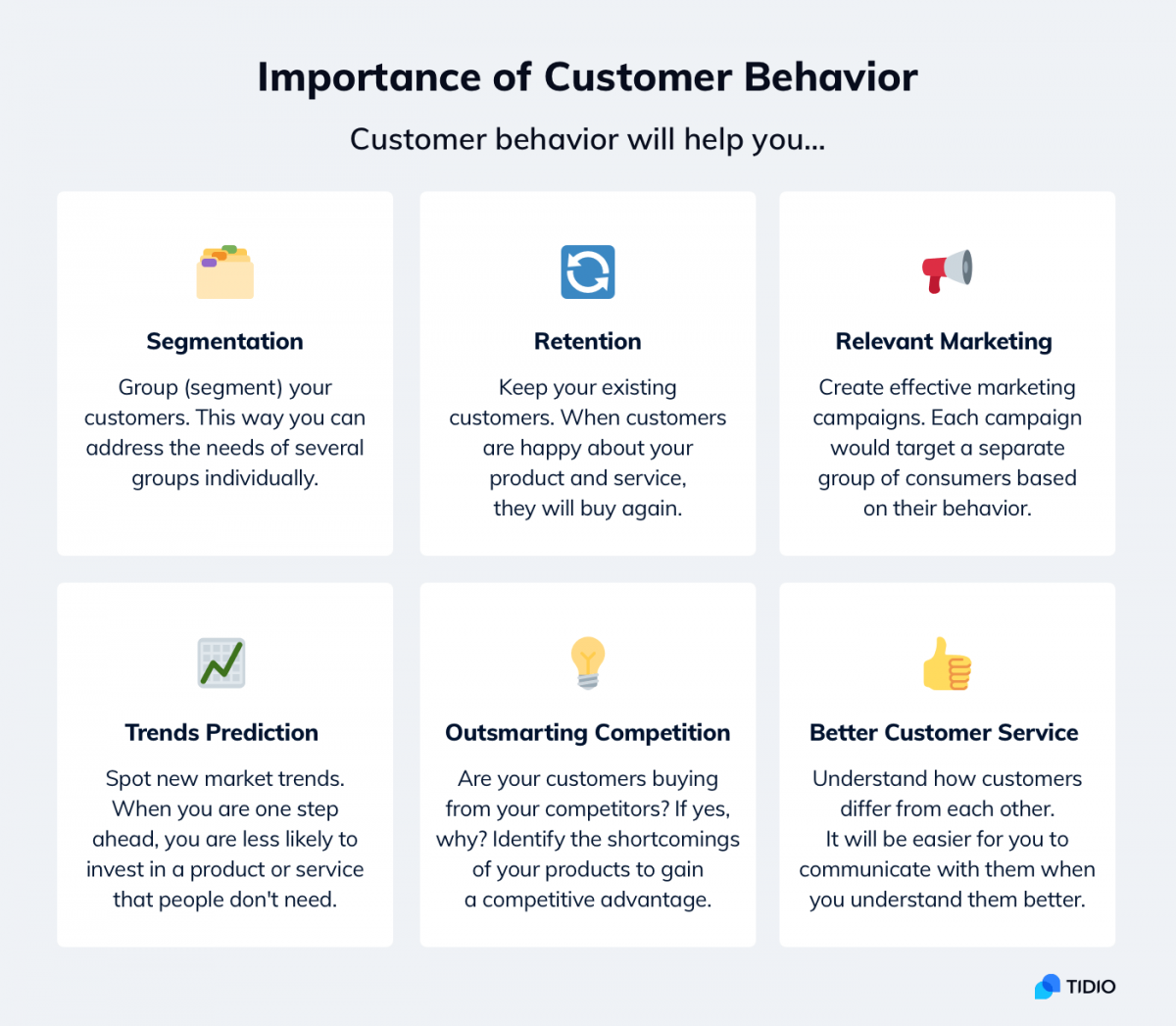
Now, to fully grasp the consumer behavior theory, you need to acquaint yourself with the so-called consumer types and customer buying behavior.
The 4 Types of Customer Buying Behavior
Consumer behavior types focus on all elements of the buying process. They encompass more aspects than customer types which only deal with personalities.
It’s good to be aware of your customers’ buying patterns, as well as their personalities. Both will give you a bigger picture of who you are dealing with and how to best approach them.
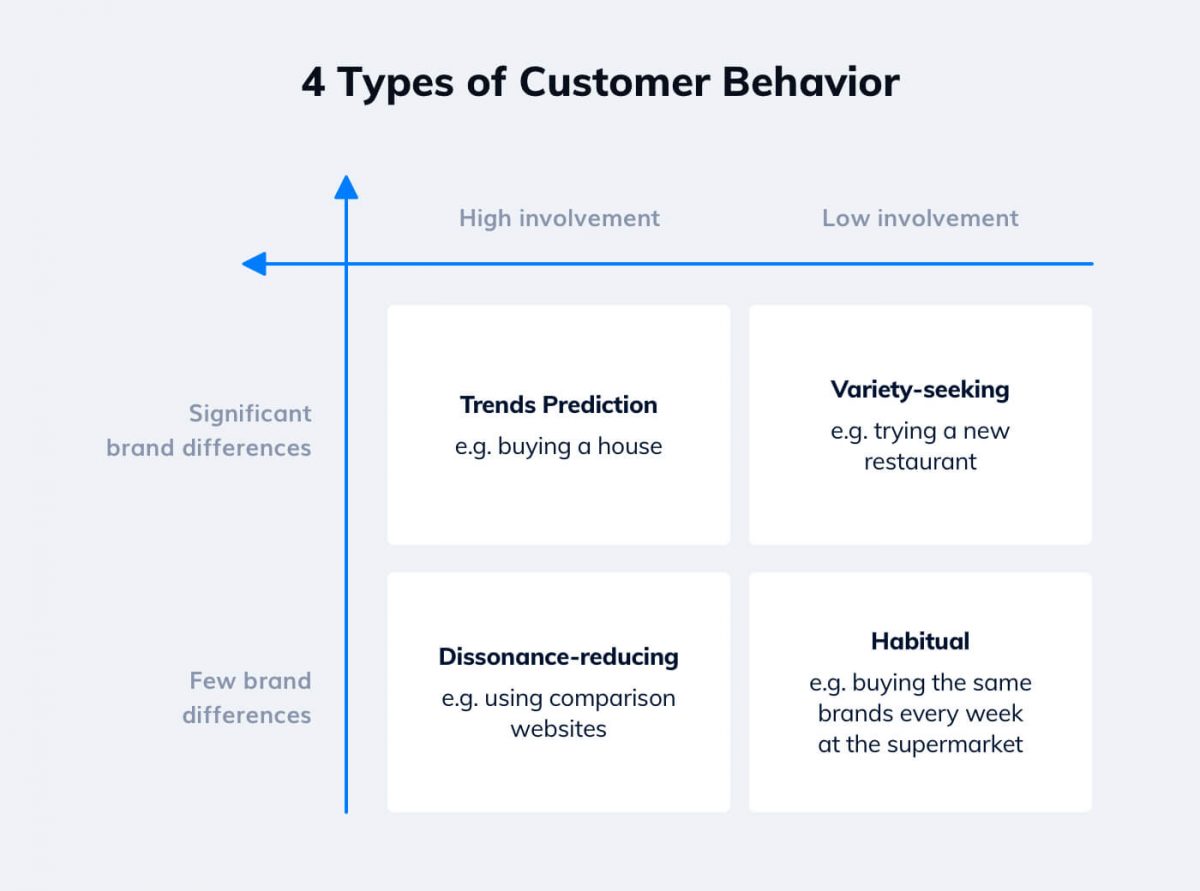
Habitual Buying Behavior
The consumer is not very involved in the buying process. They choose the product out of habit, so there isn’t too much analytical thinking going on.
E.g.: Basic grocery shopping. The consumer buys the products they know and like, or the ones that are cheap.
Complex Buying Behavior
The consumer is very involved in the buying process. They do the research, analyze, compare. They need to be sure that they spend a lot of money on the right thing.
E.g.: Shopping for an expensive item or service. Something that consumers don’t often get, like cars or flats.
Dissonance-Reducing Buying Behavior
The consumer is involved in the buying process to be sure that they don’t spend money on the wrong thing.
But, they find it hard to understand the difference between two brands of the same product they want to buy. That’s why they experience dissonance. As a result, they go for a cheaper or more convenient option. To reduce the dissonance, they start seeking information that would justify their decision
E.g.: Shopping a fairly expensive item or service, like a mobile phone. It’s not cheap and comes in many varieties. This is a problem for non-technical buyers.
Variety Seeking Behavior
The consumer seeks variety. So the main reason is to try something new, but not because they are unhappy with what they bought before.
E.g.: New perfume fragrances or pants in a different color.
So again, the major factors that influence behavior are very important here. They all impact your customer decisions.
Find out what drives your customers to sell and support better. For that, you’ll need some methods of understanding customer decisions.
Tools for Understanding Consumer Buying Patterns
You don’t need any fancy customer behavior analytics software to start getting under your customers’ skin. You can start small and still get plenty of valuable insight. Live chat and chatbots are a good starting point.
All three are available for free so you can try them out without worrying about any financial risk. (It means that you can forget about your own complex buying behavior! 😉).
Live Chat: Human to Human Live Interaction
Live chat is a solution that connects businesses with their customers and vice-versa. It speeds up communication and allows businesses to collect data about their visitors.
Step 1: Add a chat plugin to your website to connect with your visitors.
Step 2: Answer question and talk to your customers in real time.
Step 3: Close more sales and track how live chat helps your business.
Free Live Chat🚀 Not sure how your business can benefit from live chat? Head straight to: What Is Live Chat and How Your Business Can Benefit From It
Live Chat Reduces Stress and Dissonance
Fact: A chat with a support agent increases the chances for sale by 82 percent according to a recent Intercom study
Online shopping has many pros and cons. Pros: it is very convenient and accessible. Cons: it is convenient and accessible.
Wait, what?
Having many choices and (almost) unrestricted access to goods is a double-edged sword. How does it affect consumer buying patterns? For example, consumers need to spend more time on research to compare their options or understand the product/service they seek. This can be a source of stress and confusion for many buyers.
So be there for them and help them reduce the dissonance.
Chat with them as you would in a physical store. Ask them what they struggle with and what they need. You will not only earn one more happy customer but will also learn something more about your buyer’s behavior, and how to talk about your products better.
Here are a few ideas on how you can go about it.
Use the Live Visitors List to offer your help
This feature gives you a real-time overview of all the visitors on your website. You can select individual customers to start the chat with.
E.g.: There’s a visitor who is currently on your page with the shipping rates. This could be their first time buying something online from overseas. So the visitor may be unsure whether to order with you or not.
This is a good moment to step in and offer help.

Get notifications when someone is “stuck” on one page
The Live Visitor List is great when your traffic is small. Or, when you are after visitors looking to buy expensive products.
In other cases, you can create a simple chatbot to automate the selection process and react to certain customer behaviors. It will let you know when there is a visitor who’s been viewing one page for a while. This can be a specific page or any page. It depends on your goals.
E.g.: Looking at one page for several minutes can mean that visitor is very involved in the buying process. They might analyze your offer and even compare it with the competition. So, display a proactive customer service attitude, and help them out.
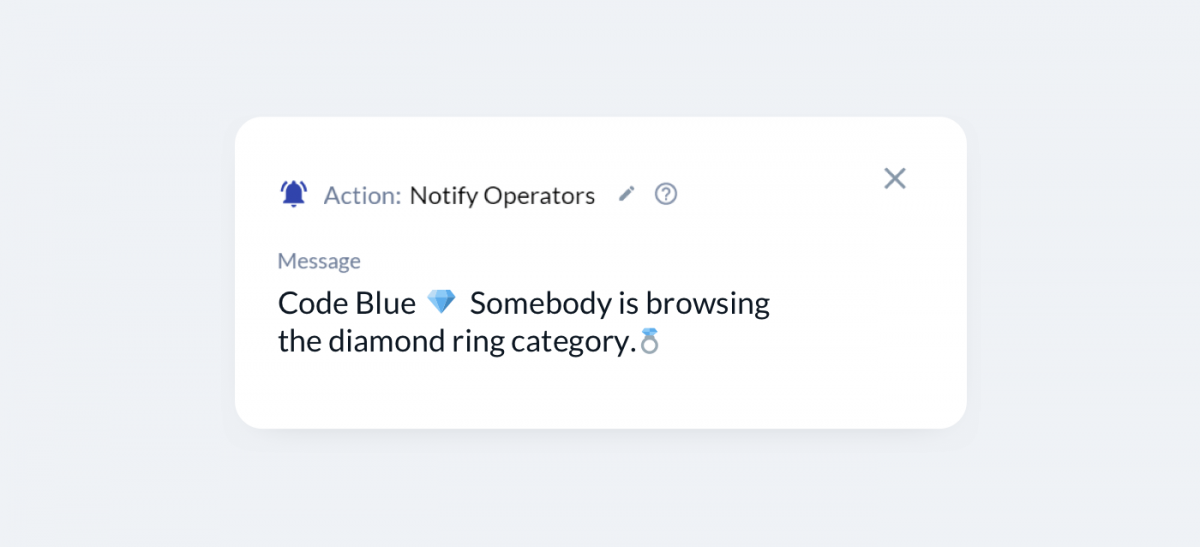
Note: Chatbot sends notifications as chat messages and emails. You can customize the message to say whatever you need.
Track your visitor’s journey with the Viewed Pages
Some customers are impulsive. They buy for no logical reason. They often don’t know what they want because they don’t know that they will end up buying. Or, they might be looking for a present without any clear idea in their mind.
E.g.: The shopping journey of such customers can be quite chaotic. They tend to switch between the pages randomly and fast. With Viewed Pages, you can retrace such buyers’ behavior and see all the pages they had visited. If you notice a visitor with extensive browsing history, chat with them. They might need your advice about what they should get.
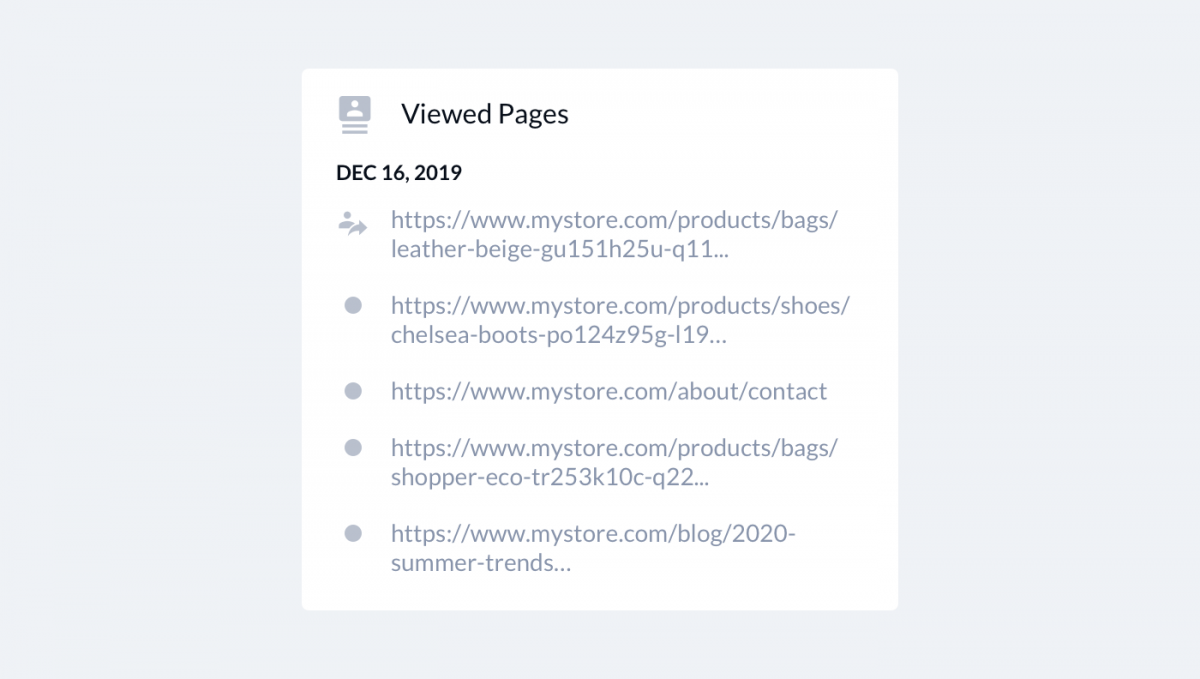
Live Chat and Customer Behavior: Summary
Live chatting is a one-on-one experience. It allows you to explore your customers’ minds through a real-time conversation. It’s also a great alternative for buyers who shy away from face-to-face or phone communication.
Chatbots: Robot to Human Live Interaction
Fact: Chatbot statistics reveal that custom and personalized automatic messages work better than generic ones.
Chatbots are fast and never tire. They can support any number of customers 24/7. They chat, track, collect and save customer behavior data (which you can later analyze and use for segmentation or marketing purposes).
Step 1: Add a chat plugin to your website to connect with your visitors.
Step 2: Create custom chatbots that answer questions or collect feedback.
Step 3: Close more sales and track how chatbots help your business.
Try it out🚀 What Is a Chatbot? Benefits of Chatbots That Will Help Your Business Grow
Modern and Traditional Data Collection in One
We’ve discussed live chat as a tool you can use to uncover some mental processes behind your customers’ behavior to help you identify their problems, and act before they leave the website.
In the case of the chatbots, we will use them to collect data about your customers’ buying patterns. They can do this in a modern way (by tracking online behavior), or traditional way (through polls, surveys, etc.).
Conduct surveys to study your customers’ behavior
You can conduct the survey in a few ways. The most common methods include online apps and emails.
But surveys can also be conversational. What does it mean? It means that the customer responds to the questions as if they were chatting with a live chat operator.
Plus, you have plenty of room to make the survey more dynamic and enjoyable. So throw in some encouraging messages or funny pictures to lighten the mood. You want the customers to feel like conversation partners, rather than test subjects.
Remember to keep chatbot messages and surveys short.
Collect customer data through engaging quizzes
Games, trivia, quizzes. They can hook users for hours. So why not use them for customer behavior analytics and research?
Let’s assume you run a shop with sports equipment. You would like to find out whether your customers are planning any activities for the upcoming season. This will help you determine potential product popularity and personalize marketing campaigns.
A chatbot can find it out for you.
It will ask the visitor or customer a series of questions. They can be straightforward, or completely crazy. It’s up to you how you will want to “interview” your audience. The answers you’d gather this way would serve as the basis for a customer behavior model for your efforts to max out your sales.
Again, remember about brevity. Keep questions and answers short.
Find out what your customers buy and how often
Depending on what you sell, customers will display different buying patterns—habitual, complex, or variety-seeking. You can use bots to find out which type of customer behavior your individual customers display. To do this, your bots will tag or apply custom properties to your customers. You can add your own tags by hand, too.
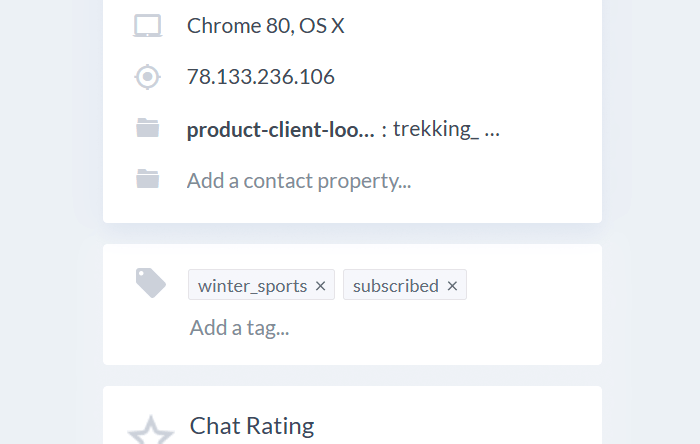
🚀 Read: Customer Segmentation Based on Their Past Purchase Behavior
Other data to look for
What do your customers buy? When do they buy? How often do they buy? These are all good questions to ask to determine which buying patterns prevail among your online store visitors.
But you can approach your customers from a different angle – by looking at the benefits they seek. In other words, you may want to find out why your customers chose a particular type of product or service. (And this time, we’re not talking about variety-seeking individuals.)
The customer’s behavior and choices can reveal which benefits, features, values, use cases, or even problems are important for them.
Let’s take a customer who buys regular t-shirts, as an example. T-shirts come in different colors, sizes, styles, compositions, and prices.
If they choose an organic cotton T-shirt, this could mean that they value quality over the price. Here, quality was the factor that determined the customer’s spending behavior.
And just like in previous cases, a chatbot can collect these tiny pieces of information as well.
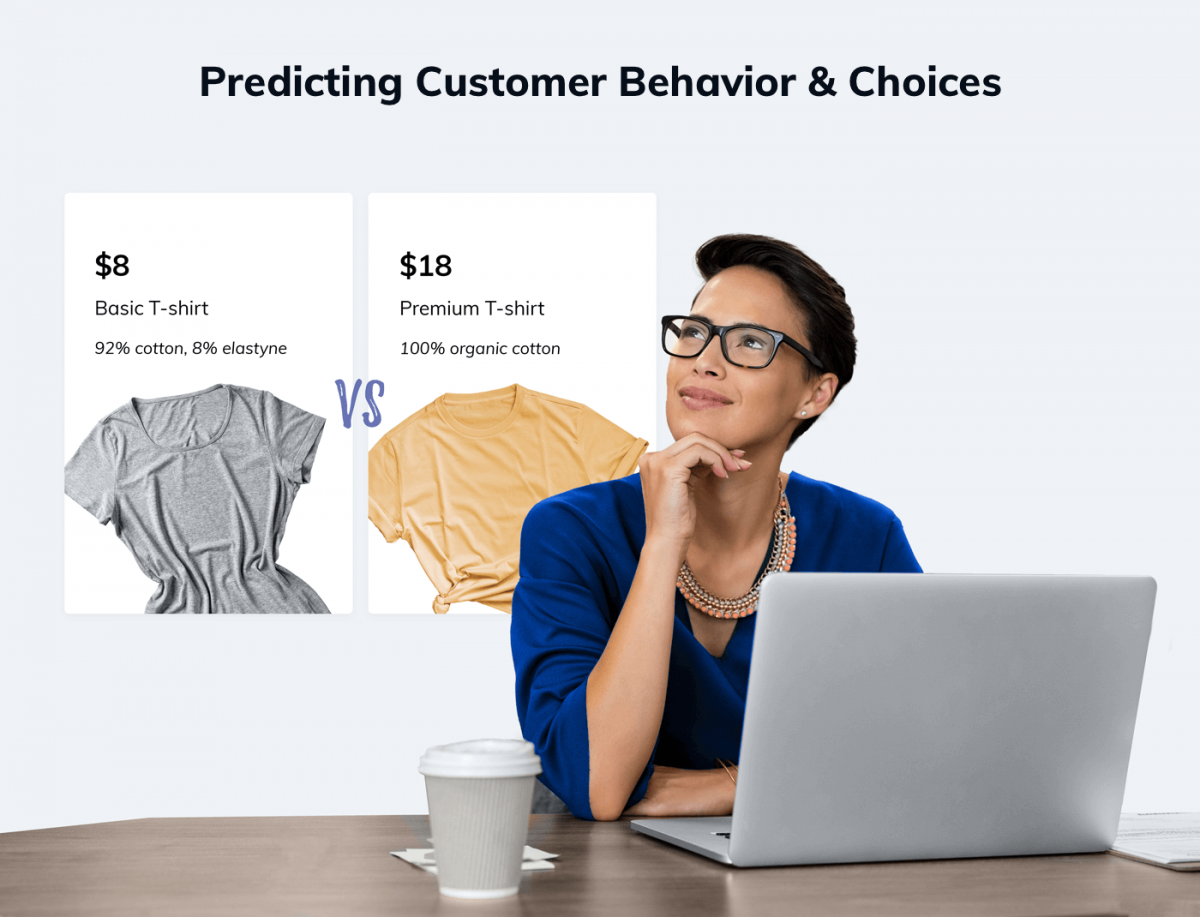
Chatbots and Customer Behavior Analysis: Summary
Chatbots automate tasks that you wouldn’t be able to do as fast as them. They act as “talking” surveys, polls, or quizzes to get the information you need. They will help you collect customer feedback, as well as their preferences or habits.
All the data you and your bots collect is stored in your CRM. This allows you to analyze and segment customers the way you want.
Customer Behavior—Key Takeaways
The consumer behavior theory examines humans and institutions as consumers. The goal is to understand why and how people shop.
Businesses that understand their customers’ behavior, hold the key to more sales. By learning what your buyer wants from your business, you can:
- improve and tailor consumer-business communication
- predict future trends on the market
- gain a competitive advantage
- retain more customers
Getting to know customers is not rocket science. You need to dedicate some time and select the tools that will help you understand and analyze your customers’ behavior.
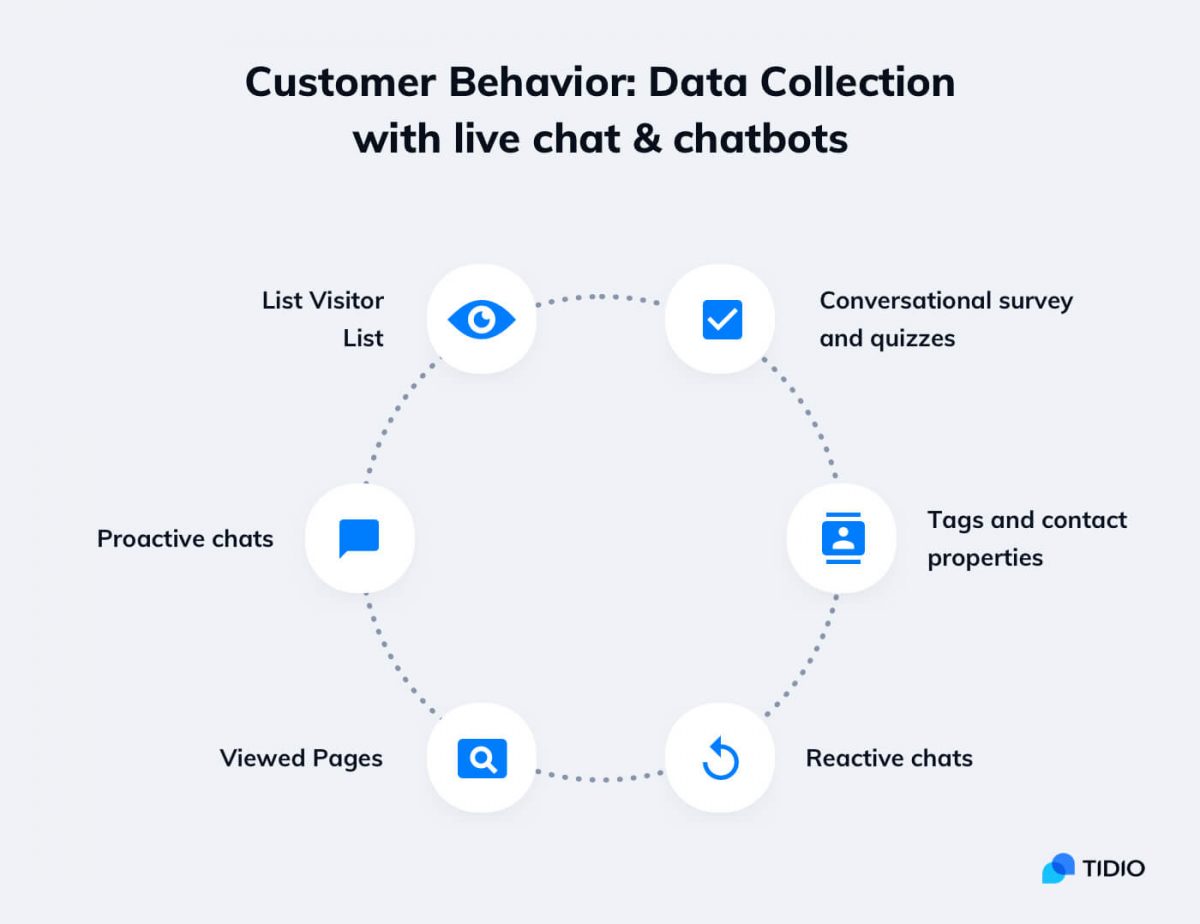
As an online business owner, you can reach for live chat and chatbots. Both of these solutions will help you collect the data you need. At the same time, they will aid you in other areas, such as marketing or customer service.
Assist your customers in real time with smart live chat tools
Before you make a decision based on gut feeling, observe your customers, talk, and listen to them. So start chatting and building relationships with them today. Competition doesn’t wait for anyone.

